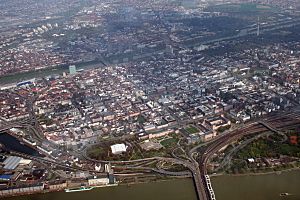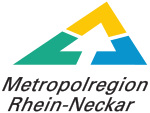Rhine-Neckar facts for kids
Quick facts for kids
Rhine-Neckar Metropolitan Region
Metropolregion Rhein-Neckar
|
||
|---|---|---|
|
||

Location of the Rhine-Neckar Metropolitan Region in Germany
|
||
| Country | ||
| States | ||
| Largest Cities | Mannheim Ludwigshafen Heidelberg |
|
| Government | ||
| • Type | Metropolregion Rhein-Neckar GmbH | |
| Area | ||
| • Metro | 5,637 km2 (2,176 sq mi) | |
| Population | ||
| • Metro | 2,362,000 | |
| • Metro density | 419/km2 (1,090/sq mi) | |
| Time zone | UTC+1 (CET) | |
| Website | m-r-n.com (archived) | |
The Rhine-Neckar Metropolitan Region (called Metropolregion Rhein-Neckar in German) is a very important area in southwestern Germany. It's often called the Rhein-Neckar-Triangle. This region is located between the Frankfurt/Rhine-Main area to the north and the Stuttgart Region to the southeast.
About 2.4 million people live in the Rhine-Neckar region. Its biggest cities are Mannheim, Ludwigshafen, and Heidelberg. Other important cities include Speyer and Worms, which used to be special "Free Imperial Cities" long ago.
The region also includes parts of the Baden and Palatinate wine regions. These are famous for growing grapes and making wine. The area stretches across three different German states: Baden-Württemberg, Rhineland-Palatinate, and Hesse. People here feel a strong connection to the historical Electorate of the Palatinate state.
The region gets its name from two rivers, the Rhine and the Neckar. These two rivers meet in the city of Mannheim. Since 2005, the Rhine-Neckar area has been officially recognized as a major European region.
Contents
A Strong Economy in Rhine-Neckar
The Rhine-Neckar Region is one of Germany's most important economic areas. Many big global companies are located here. These include BASF, SAP, Heidelberger Druckmaschinen, and Fuchs Petrolub. There are also many smaller and medium-sized businesses.
This region is known as the largest technology hub in Europe. It's sometimes called the IT-Cluster Rhine-Main-Neckar. This means many technology companies are grouped together here.
In 2010, the region produced goods and services worth about 67.5 billion Euros. More than half of these goods (almost 58%) were sent to other countries. Key industries include making cars, building machines, chemicals, and information technology. Biotechnology, life sciences, energy, and environmental industries are also very strong. The creative and cultural industries also play a role. The Rhine-Neckar region is a leader in many of these fields, both in Germany and worldwide.
More recent numbers from 2015 show that the region's total economic output was 92.6 billion Euros. The average income per person was 39,139 Euros. The Rhine-Neckar region has one of the lowest unemployment rates in Germany. According to the "Industrie und Handelskammer" (IHK), there are 134,000 companies registered here. People in the Rhine-Neckar region also have a lot of money to spend. This makes it a great place for shops and businesses to set up. In 2008, the average income per person was 19,300 Euros. This was 300 Euros more than the national average in Germany.
Getting Around: Transportation
The Rhine-Neckar Metropolitan Region is a major center for transportation in Europe. Its central location and good infrastructure make it easy to reach. You can get around the region and connect to national and international places.
Drivers can use major highways like the A5/A67 and A61/A65 (running north to south). The A6 highway goes from east to west. There are also many federal highways.
If you want to fly, Frankfurt International Airport is nearby. You can reach it in just 31 minutes by ICE train from Mannheim Hbf. For shorter business trips, there's Mannheim City Airport. It even has its own local airline called Rhein-Neckar Air. Another regional airport is in Speyer.
Traveling by train is also easy. You can reach major German cities and European capitals directly. Mannheim's main train station is very busy. About 240 long-distance trains leave every day. This makes Mannheim the second-largest ICE train hub in Germany. It connects the region to the European long-distance rail network. The local public transport system, VRN, helps people get around the region. The Rhine-Neckar S-Bahn is the main part of this system.
The Mannheim/Ludwigshafen harbor complex is also very important. It has the second-largest railway yard in Germany. It's also one of the biggest inland ports in Europe. This makes it a key place for moving goods across Europe. The Mannheim railway yard handles up to 5,300 freight cars every day.
Learning and Research: Education
The Rhine-Neckar region has a long history of scientific discovery. In 1386, the University of Heidelberg was founded. It was Germany's very first university. Today, it is still one of the most respected universities in Germany.
Around 94,000 students attend the region's universities and colleges. About one in ten of these students come from other countries. The Rhine-Neckar Region has 22 higher education institutes. They work with famous research centers like the European Molecular Biology Laboratory and the German Cancer Research Center. This creates a great environment for new technologies. In the Mannheim/Heidelberg/Ludwigshafen area, more than twice as many experts work in research compared to the German average.
Cities and Districts in the Region


Here are some of the main cities and districts in the Rhine-Neckar region, grouped by their German state:
- Mannheim (324,787 people)
- Heidelberg (145,642 people)
- Rhein-Neckar-Kreis (531,723 people, including Sinsheim, Walldorf, and Weinheim)
- Neckar-Odenwald-Kreis (151,043 people)
- Kreis Bergstraße (265,868 people, including Bensheim and Heppenheim)
- Ludwigshafen (163,002 people)
- Frankenthal (Pfalz) (47,534 people)
- Landau in der Pfalz (41,687 people)
- Neustadt an der Weinstraße (53,898 people)
- Speyer (50,280 people)
- Worms (80,955 people)
- Rhein-Pfalz-Kreis (148,428 people)
- Landkreis Bad Dürkheim (134,869 people)
- Landkreis Germersheim (124,894 people)
- Landkreis Südliche Weinstraße (110,658 people)
Culture, Nature, and Sports
The Rhine-Neckar Region is rich in culture and beautiful nature. It has over 80 theaters and more than 200 museums and art galleries.
You can find three World Heritage Sites here: Lorsch Abbey, parts of the Upper Germanic-Rhaetian Limes (old Roman Empire borders), and the Speyer Cathedral. There are also over 200 castles, cathedrals, and palaces. Famous historical places include Heidelberg Castle, Schwetzingen Castle, and Hambach Castle.
The region is home to three nature parks: the Palatinate Forest, Neckartal-Odenwald, and the Bergstrasse-Odenwald geopark. There are also four wine-growing areas: Baden, Hessische Bergstrasse, Palatinate, and Rhine-Hesse.
For sports fans, the Rhine-Neckar region has professional teams. These include Adler Mannheim (ice hockey), Rhein-Neckar Löwen (handball), and SV Sandhausen and 1899 Hoffenheim (soccer). Important sports venues are the Golf Club St. Leon-Rot and the Hockenheimring motorsport race track. The Olympic training center helps local athletes prepare for the Olympics. With over 2,700 sports clubs, there are many ways for people to stay active, from the Palatinate Forest to the Odenwald mountains.
The SAP Arena, built in 2005, is the region's most important indoor event venue. The Rhein-Neckar-Arena opened in 2009. It is the new home stadium for the 1899 Hoffenheim soccer team.
See also
 In Spanish: Región metropolitana Rhein-Neckar para niños
In Spanish: Región metropolitana Rhein-Neckar para niños
- Metropolitan regions in Germany


